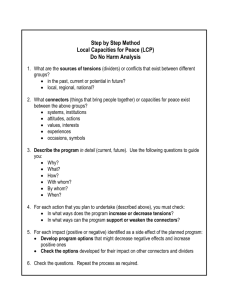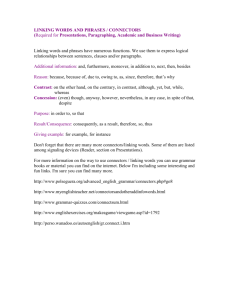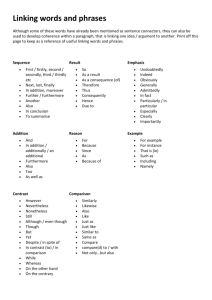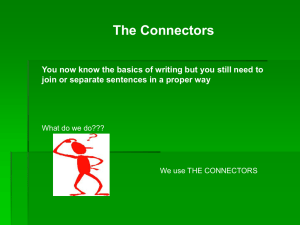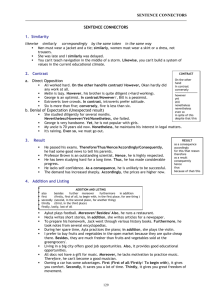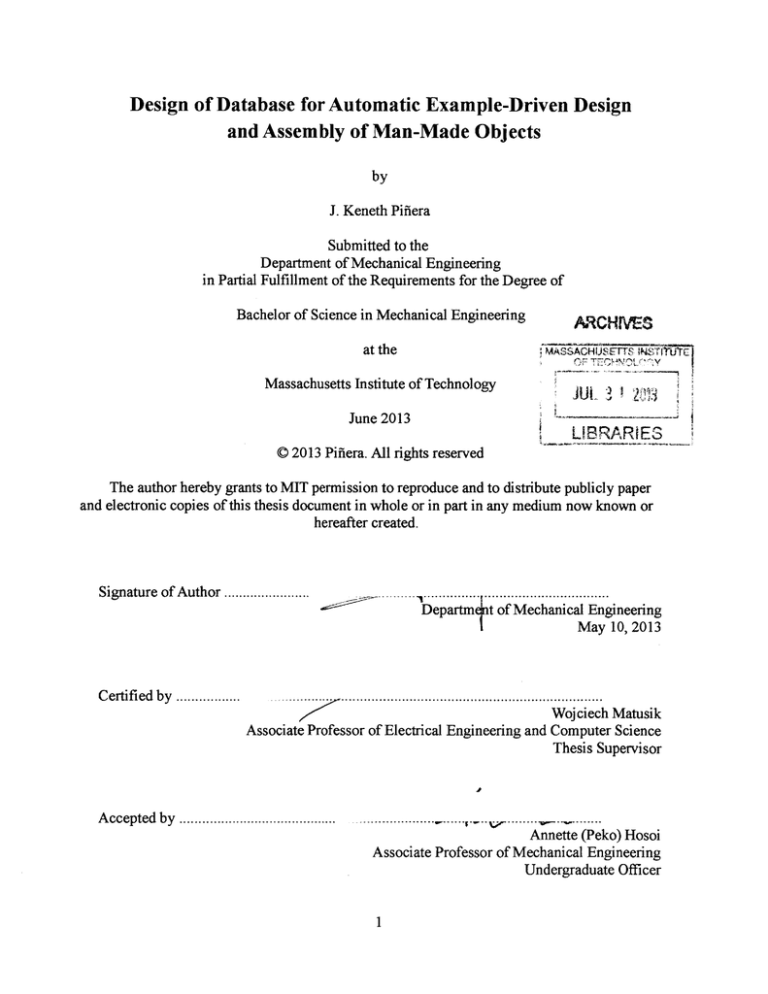
Design of Database for Automatic Example-Driven Design
and Assembly of Man-Made Objects
by
J. Keneth Pifiera
Submitted to the
Department of Mechanical Engineering
in Partial Fulfillment of the Requirements for the Degree of
Bachelor of Science in Mechanical Engineering
at the
AeRCHM-3
MASSACHUSMST
Massachusetts Institute of Technology
4,8, Mu C_
JUL 3AR
June 2013
ULBARIES
©2013 Pifiera. All rights reserved
The author hereby grants to MIT permission to reproduce and to distribute publicly paper
and electronic copies of this thesis document in whole or in part in any medium now known or
hereafter created.
Signature of Author .....................
Certified by .................
............. .................................
Departm t of Mechanical Engineering
May 10, 2013
.... ...
...
.... ....... .... ... .... ... .... ... ..... ... . .
Wojciech Matusik
Associate Professor of Electrical Engineering and Computer Science
Thesis Supervisor
A#
A ccepted by ..........................................
..
.............
..
......
.....
. .1.........
Annette (Peko) Hosoi
Associate Professor of Mechanical Engineering
Undergraduate Officer
1
Design of Database for Automatic Example-Driven Design
and Assembly of Man-Made Objects
by
J. Keneth Pifiera
Submitted to the Department of Mechanical Engineering
on May 10, 2013 in Partial Fulfillment of the
Requirements for the Degree of Bachelor of Science
in Mechanical Engineering
ABSTRACT
In this project, we have built a database of models that have been designed such that they
can be directly fabricated by a casual user. Each of the models in this database has design
specifications up to the screw level, and each component has a direct reference to a commercial
part from online retailers such as McMaster-Carr and Home Depot. This database was built with
the purpose of assisting a data-driven approach to customizable fabrication. This system allows a
casual user to create a 3D model input with rough specifications and receive a list of parts that,
when assembled, will create the model specified. Using this system and database, we were able
to successfully design and fabricate three pieces of furniture and therefore proved the data-driven
method approach to be valid.
Thesis Supervisor: Wojciech Matusik
Title: Associate Professor of Electrical Engineering and Computer Science
3
Acknowledgements
I would like to thank Professor Wojciech Matusik and Adriana Schulz for proposing such a
project and for their guidance. I would also like to thank Baker Logan, Nilu Zhao, and other
fellow UROPs that contributed to this project. Finally, I would like to thank my supportive
family, loving girlfriend, and encouraging friends for helping me through these past four years at
MIT. Without them, this would not have been possible.
4
Table of Contents
1. Introduction .......................................................................................................................... 7
2. Overview and M ain Challenges ............................................................................................ 8
2.1 Composability ................................................................................................................ 8
2.2 Functionality and Articulation ....................................................................................... 9
2.3 Structure Preserving M anipulation ................................................................................ 9
2.4 Connectivity ................................................................................................................... 9
2.5 M anufacturing ................................................................................................................ 9
2.6 Approach ...................................................................................................................... 10
3. Design ................................................................................................................................ 11
3.1 Creating Parts and Connectors ..................................................................................... 11
3.2 Creating A ssemblies .................................................................................................... 12
3.2.1 Specifying Functionality ....................................................................................... 13
3.3 Connectivity ..................................................................................................................... 14
4. Conclusion ......................................................................................................................... 16
4.1 Future Work .................................................................................................................. 17
References .............................................................................................................................. 18
5
List of Figures
Figure 1: A visual representation of how the hierarchy for a given assembly may look. In this
case, it is of a desk with a shelving unit. The most basic constituents, being the individual
shelves as well as the box that contains both, are on the bottom tier in parallel. Next, the
shelving unit assembly that contains the three aforementioned parts is in parallel with the legs
and top support on a second tier, which are all part of the Bottom Assembly. Finally, this
Bottom Assembly is in parallel with the table top and are what ultimately make up the full
8
assem b ly .....................................................................................................................................
Figure 2: Image of typical output using generative templates and an input. The grey model in the
front middle is the input and all other models are models derived from the features of the input
10
with differences in scale and number of features .................................................................
Figure 3: A snapshot from the CAD software model of Gaitan, a simple, two-tier table
11
com posed of plywood, balsa wood, and screws.......................................................................
version
and
"hole"
"cut"
a
Figure 4: Image of part P.1 125T35.Gaitan.BottomShelf.CH, which is
of P.1 125T35. This part is Gatain's larger top piece and has been modeled by editing the
original raw material piece P. 1125T35, a 36" x 48" sheet of plywood from McMaster-Carr.
The name and dimensions of each piece are stored in an Excel spreadsheet which keeps track
12
of every part of every model used in the database. ..............................................................
Figure 5: Gaitan hierarchy showing the different tiers that allow for composability as discussed
in Section 2.1. The top-level tier is the assembly as a whole with four subordinates. Three of
the four subordinates are simply pieces such as "Small Top", "Central Brace", and
"Connectors", but "Bottom Assembly" has three subordinates of its own. This is the exact
structure we were looking to have in these models as it allows for any one subordinate to be
replaced by another, whether it be an individual part or an entire subassembly................... 13
Figure 6: An image of Louise, a database model that has functionality in the way of hinges on
doors. In order to create the functionality assembly, a set of coordinates must be mated to the
object that will be moving, in this case the door that will rotate via the hinge. This
subassembly is then mated with the larger assembly in order to create the model. It is
important that the coordinate system of the functionality subassembly matches the coordinate
system orientation of the final assembly, as this allows the software to know how the two
14
objects move with relation to each other on a particular axis. ..............................................
in
every
component
box
around
a
bounding
creates
software
how
the
depicting
7:
Image
Figure
a model to approximate parts and be able to create relations between them like co-linearity,
15
concentricity, and co-planarity ............................................................................................
Figure 8: Images of the connectivity software (left) that allows us to input the connections
between pieces and what the interpreted connectivity graph looks like for Gaitan, the table
seen in Figure 3. The image of the software pertains specifically to one of the legs, which can
be seen is connected to four connectors and nothing else. The connectors then attach the legs
to the large top, which is attached to the central brace via four more connectors, and finally
the central brace is also attached to small top via more connectors as can be seen in the figure.
15
Figure 9: Image of input model (left) and completed model Sarah (right)............................... 16
Figure 10: Image of input model (left) and completed model Leah (right)............................. 16
Figure 11: Image of input model (left) completed model Danielle (right)............................... 17
6
1. Introduction
Fully customized objects are becoming commonplace in our daily lives. Whether it is
jewelry, toys, furniture, or simple machines, there is growing interest in allowing casual users to
design and then fabricate their own objects. We have seen this to, be true with the recent growth
of 3D printers. What started as a concept for designers to dream about is now starting to become
a common item that allows for complete control over the design and manufacturing of their
creations. While 3D printers are great for many applications, they are limited in terms of
materials, dimensions, and cost
Our goal is to allow customized design and assembly of man-made objects using common
materials (e.g. wood, acrylic, screws, bolts, etc.) that most users have access to and can purchase
easily. In order to do this, we are looking to create a system that will allow for a 3D model
designed by the user to be used as an input from which a list of parts and connectors necessary
for assembly can be generated. Although a user may know what object he or she wants, they may
not know how to cut every piece, know where every connector should go, or know how two
pieces should fit together.
Previous work [Lau et al. 2011] has approached this problem by using a grammar. The
grammar, or set of rules, is applied to a software model to segment it into parts and connectors
with which the user can then use to assemble his or her object. While this method works for a
small number of models, it does not scale well because it needs many rules to compensate for
complexity, as each rule is discrete to every category (e.g. cabinets or tables). We have chosen an
alternative approach, one that consists of machine learning. Our system uses a database that
supports software in order to extrapolate data from models and ultimately "learn" the rules of
constructing models. Each of these models in the database contains information such as
dimensions, alterations, limitations, and direct links to where each piece can be purchased. The
user creates a model for input, the software compares the input to models in a database, and is
then able to extrapolate what parts and connectors from online catalogs are necessary to
assemble the original input. This thesis is focused on the design and creation of such a database.
Designing a database that is varied enough to accommodate almost any user input, yet be
small enough to force the software to extrapolate the rules without being trivial is a delicate
balance. Knowing that furniture will be the focus of our project, there are five major issues that
need to be addressed: Composability (2.1), Functionality and Articulation (2.2), Structure
Preserving Manipulation (2.3), Connectivity (2.4), and Manufacturing (2.5).
We have chosen to focus on furniture as the category spans a large and practical workspace
for a project such as this one. Most furniture is relatively simple and easy to construct, so the
concept can be proved quickly. Furthermore, furniture is highly practical, easily customizable,
scaleable, and has a vertical assembly process. Our database also contains other man-made
objects such as doll houses, jungle gyms, and go-karts, but those areas are yet to be completed.
These will be further developed in coming semesters through MIT's Undergraduate Research
Opportunity Program which allows undergraduates to conduct meaningful research in
conjunction with PhD students and post-docs.
The structure of this thesis is as follows. Chapter 2 gives a brief and broad overview of the
main challenges faced during the project. This chapter is meant to simply give an idea of what
these issues are from a top-tier perspective. Chapter 3 goes into the details of what these five
7
issues actually are and how they were resolved by using an example of creating a model for the
database. Chapter 4 is a conclusion in which the results of the project are discussed as well as the
future work that will be required to further improve our system.
2. Overview and Main Challenges
The following sections will discuss the main challenges that needed to be overcome in order
to have a successful project. These include composability, functionality and articulation,
structure preserving manipulation, connectivity, and manufacturability of each model.
2.1 Composability
The first main challenge of this project is to create a database and software that allow for
composability. In other words, the software and database need to allow the user to create
completely new objects using any number of combinations of pre-existing parts. Our goal is to
decompose models in the database that we know can be manufactured and be able to manipulate
them in various scales. For example, suppose a user would like a desk that had storage shelves.
They would use the interface to add a table top, four legs, and the shelves to the workspace. This
could seem trivial but there are many possibilities for how this could be done. They could want
two equally sized shelves, or they could want a small top shelving area and a larger bottom area,
or they could want three shelves instead of two. These choices can quickly multiply until the user
has an almost infinite degree of variation because there are micro-level refinement possibilities.
In order to create this kind of composability for the input models, we need to create a
segmentation technique that will allow for each model in the database to be broken down to its
individual constituents. This segmentation comes in the form of a hierarchy we have developed
that clearly denotes the level of every single component within a model in the database.
The hierarchy breaks down as seen in Figure 1, which depicts an example hierarchy of a
desk with a shelving unit.
Full
Assembly
Bto
Table Top
Shelving
Unit
Top Shelf
Bottom
Shelf
Leg
Top
Bounding
Structure
Figure 1: A visual representation of how the hierarchy for a given assembly may
look. In this case, it is of a desk with a shelving unit. The most basic constituents,
being the individual shelves as well as the box that contains both, are on the
bottom tier in parallel. Next, the shelving unit assembly that contains the three
aforementioned parts is in parallel with the legs and top support on a second tier,
which are all part of the Bottom Assembly. Finally, this Bottom Assembly is in
parallel with the table top and are what ultimately make up the full assembly.
8
The hierarchy is a vertical one with the smallest constituents, those making up the smallest
components of the assembly, being at the bottom and the complete assembly being at the top.
The software can take this grouping information and know how to replace certain pieces
depending on the user's input. As mentioned in the example above, if the user wants three
shelves instead of two, the software can simply add a middle shelf in the same tier of the
hierarchy as the other two shelves. This allows the user to be able to have composability at
different levels and helps expand the database.
2.2 Functionalityand Articulation
On top of creating stationary objects like desks and chairs, users may also want to create
objects that have a function like a chair with wheels or a hinged door or a sliding drawer. To be
able to do this, the user must have a way to specify the desired functionality. We can create this
freedom of being able to design dynamic objects by implementing a very simple naming scheme.
This scheme, explained in more detail in Section 3.2.1, allows parts to have two degrees of
freedom: rotation and translation.
2.3 Structure Preserving Manipulation
Beyond the user being able to create new objects from different parts, they can also scale
their objects to whatever size they want. They could want a taller table or a desk that is wider.
Obviously, the input mesh cannot be scaled uniformly because the result would be a table with a
tremendously thick top or a desk that has incredibly wide legs. To solve this issue, we base
scaling off of templates that can be resized independently of one another.
We need a way to scale different components at different rates but maintain the structural
integrity of the original assembly, otherwise, scaling could result in objects that are not stable. In
order to manipulate components while preserving the structure, we can use the fact that the
models are already broken down into constituents and can therefore apply restrictions to scale
each component individually.
2.4 Connectivity
After the user has designed an object with whatever configuration and scale they desire, the
software needs to be able to put all the pieces back together in the correct manner. The software
will be able to "learn" from the models in the database how pieces connect together and will
therefore be able to do this in real time as the user is designing an object.
This machine learning is made possible by having information of how components connect
in order to make up the model. The information is provided to the software via a connectivity
graph, which will be explained in more detail in Section 3.3.
2.5 Manufacturing
Finally, instructions that will allow the user to assemble a functional and structurally stable
object must be created. Creating these instructions requires a list of parts and connectors that can
be easily accessed by most people and that can completed using minimal tools or tools that are
easy to acquire and most people probably own. For this reason, every single part and connector
in every database model is linked directly to an online catalog where they can be purchased. We
have linked all parts and connectors to products that can be found at Home Depot as well as
McMaster-Carr. This is a major constraint as far as creativity because it restricts material choices
to wood, glue, screws, and bolts while also restricting manufacturing processes to cutting and
9
drilling. However, we felt that these restrictions were justified because we want the system to be
accessible to beginners and those that may not have a lot of experience designing and fabricating
objects.
2.6 Approach
Because of the challenges described in Chapter 2, we decided to create a database of parts
(generally pieces cut from raw material) and connectors (e.g. screws, bolts, hinges, etc.) that has
each individually linked to an online catalog.
Using these parts, we created CAD models of man-made structures such as tables, chairs,
doll houses, jungle gyms, and go-karts. Each of these CAD models carried crucial information
about the particular model's construction and functionality.
First, these CAD models were all designed with a very specific hierarchy that allows for
composability when the user goes on to design their own piece as described in Section 2.1. Then,
each model that has any functionality, whether it be a wheel or a door or a drawer, has these
functionalities notated in a special subassembly that tells the software of its capabilities. Finally,
after the CAD models were completed, a connectivity graph had to be completed for each one.
These connectivity graphs were crucial as they are what allow the software to "learn" from the
database. We, as designers, had to ensure that the program understood how any two pieces in a
CAD model assembly were put together and interacted. The connectivity graph was a way to
ensure that the program was interpreting the models correctly and that it would indeed "know"
that a screw holds two pieces of material differently than glue does, for example.
Using the information from the CAD models, a set of "generative" templates was then able
to be created, allowing for new models to be derived using inputs as seen in Figure 2.
Figure 2: Image of typical output using generative templates and an input. The
grey model in the front middle is the input and all other models are models
derived from the features of the input with differences in scale and number of
features.
10
3. Design
This section will walk the user through the process of designing a database model from start
to finish. Particularly, we will walk through the design of a table named Gaitan. During this
example, we will explain what composability, hierarchy, functionality, connectivity, and
manufacturability are exactly, how they affect each model, and how they apply to designing
models.
3.1 Creating Parts and Connectors
Each model in the database is designed using SolidWorks, a CAD software. The approach is
much the same as it would be if these models were physical entities to be built by hand. This
means that every model begins by CAD-ing the raw materials, all of which come from online
catalogs such as McMaster-Carr or Home Depot, and then modifying them through cuts and
holes to achieve the desired size and shape of each part.
Gaitan, as seen in Figure 3, is a simple shelving unit consisting of plywood sheets, balsa
wood boards, hinges, and connectors in the form of screws. To begin, we must first create the
raw material models using the CAD software. For example, the larger top of Gaitan is a 36"
diameter piece of plywood, but it was cut out of a 36" x 48" piece, McMaster-Carr #1 125T35.
The original piece is modeled and saved as P.1 125T35 into the repository. Apart from having the
SolidWorks file in the repository, a separate STL file that stores the corresponding 3D mesh
must also be saved in order for the Design by Example software to be able to understand the
mesh generated later. Also, the exact dimensions, part numbers, direct links to the online catalog
where the parts can be ordered, and any special notes of each piece are logged into an Excel
spreadsheet. This helps keep track of every part as well as setting limits for the software as to the
size of each part. Furthermore, tracking special notes on dimensions allows us to limit when a
piece can be cut in a certain direction or when a new piece is needed. For example, a stock piece
can be cut to a smaller dimension in the X and Y directions, but the thickness, or Z direction
cannot be modified, otherwise a new stock piece must be used.
Figure 3: A snapshot from the CAD software model of Gaitan, a simple, two-tier
table composed of plywood, balsa wood, and screws.
11
Once all of the raw materials have been modeled, we then edit them to meet the desired
specifications. For the piece mentioned before, we manipulate the CAD model of the original
raw material by cutting it to a 36" diameter and creating 16 holes for screws. Part
P.1 125T35.Gaitan.BottomShelf.CH can be seen in Figure 4.
Figure 4: Image of part P.1 125T35.Gaitan.BottomShelf.CH, which is a "cut" and
"hole" version of P.1 125T35. This part is Gatain's larger top piece and has been
modeled by editing the original raw material piece P.11 25T35, a 36" x 48" sheet
of plywood from McMaster-Carr. The name and dimensions of each piece are
stored in an Excel spreadsheet which keeps track of every part of every model
used in the database.
Connectors like screws, bolts, and hinges are a bit more straightforward as McMaster-Carr
has CAD models of these pieces already. Each must be downloaded from the McMaster-Carr
website and follow the same procedure of being saved as a SolidWorks part, an STL file, and
notating its dimensions. Connectors that are more abstract (e.g. glue) or that do not have an
associated 3D model (e.g. the ones from Home Depot) must be designed individually.
The naming scheme that we have chosen for parts and connectors is straightforward. As was
mentioned before, the larger top of Gaitan is P.1125T35.Gaitan.BottomShelf.CH. The "P"
represents that it is a part, the number matches the McMaster-Carr part number, "Gaitan"
symbolizes that is part of the Gaitan model, "BottomShelf' is a description of the specific part,
and finally "CH" means that the original part has been cut and had holes drilled in order to match
the necessary dimensions and features. Connectors follow the same naming scheme except for
the fact that they all begin with "C", which stands for "connector".
3.2 Creating Assemblies
After having all of the parts and connectors necessary to compose the model, we must then
create assemblies. The idea behind these assemblies is to group the components that make up the
whole in an organized and sensical manner. We have opted to create a hierarchal structure that
allows for composability as mentioned in Section 2.1.
12
The idea behind the hierarchy is to group pieces of the model that should be together. This
allows for the software to break down each model into its constituents and swap out subassemblies with different ones, creating composability. The idea is akin to any complex system.
Take a car, for example. As a whole, it is a car but in more detail, the car is composed of many,
many subassemblies. Each of these sub-assemblies in a model is modular and can be swapped
out just like the wheels or tires on a car.
More specifically, in the case of Gaitan, there are multi-step assemblies due to the fact that
not every part is on the same tier. Figure 5 shows the hierarchy for Gaitan.
Gaitan Assembly
Bottom
IAssemblySal
La rge<Top
Legs (x4)
SalTp
Central
Brace
o
on
nets
Connectors
Figure 5: Gaitan hierarchy showing the different tiers that allow for
composability as discussed in Section 2.1. The top-level tier is the assembly as a
whole with four subordinates. Three of the four subordinates are simply pieces
such as "Small Top", "Central Brace", and "Connectors", but "Bottom Assembly"
has three subordinates of its own. This is the exact structure we were looking to
have in these models as it allows for any one subordinate to be replaced by
another, whether it be an individual part or an entire subassembly.
3.2.1 Specifying Functionality
Furthermore, more advanced assemblies can be made to create functionality like rotation for
the hinges or wheels. Functionality subassemblies are simple but a bit different than the others.
The role of each functionality subassembly is to allow the program to interpret how pieces move
in relation to each other. Because Gaitan does not have any functionality, we will use another
database model, Louise, as an illustrative example as to how functionality subassemblies are
made.
To create a functionality subassembly, a coordinate system is mated to the part, not the
connector, that will end up moving. In the case of Louise, two functionality subassemblies would
be created, one for each door. These would be named FUNCROT_X_0_90 for the left and
FUNCROT_X_90_0 for the right, signifying that the functionality is a rotation of 90 degrees
around the X axis of the assembly. The coordinates of the functionality assemblies and the
overall assembly must match in order for the software to correctly interpret the functionality, so
it is crucial to ensure that this is true. This is shown in Figure 6.
13
Figure 6: An image of Louise, a database model that has functionality in the way
of hinges on doors. In order to create the functionality assembly, a set of
coordinates must be mated to the object that will be moving, in this case the door
that will rotate via the hinge. This subassembly is then mated with the larger
assembly in order to create the model. It is important that the coordinate system of
the functionality subassembly matches the coordinate system orientation of the
final assembly, as this allows the software to know how the two objects move
with relation to each other on a particular axis.
It is imperative to create the functionality subassemblies with the correct hierarchy because
they need to be interchangeable, just like any other subassembly. Also, they need to be properly
segmented in case there are two or more degrees of freedom. For example, if Louise was on
wheels (e.g. the type found on office chairs), then the wheels would need to rotate around a
central pivot to allow maneuverability in every direction as well as rotate down the central,
horizontal axis to allow for movement forward and backward. Each of these functions is not
mutually exclusive, much like the elbow and shoulder joints of an arm.
3.3 Connectivity
Once all of the components have been properly mated in SolidWorks, we have a digital
model of Gaitan. However, this is not enough information for the model to be a useful database
component as there is no information regarding the interactions and limits between two parts that
the software can interpret. To remedy this issue, we have developed connectivity software that
creates a connectivity chart.
This software takes full software models from 3DXML format and interprets the position of
every piece in the model using the STL files mentioned in Section 3.1. Specifically, it creates a
14
bounding box around each component that allows it to create relationships between the boxes.
These bounding boxes are simply rectangular prisms that approximate every piece as seen in
Figure 7, allowing the software to create relations between parts such as co-linearity,
concentricity, and co-planarity.
Figure 7: Image depicting how the software creates a bounding box around every
component in a model to approximate parts and be able to create relations
between them like co-linearity, concentricity, and co-planarity.
Once a 3DXML file is opened using the connectivity software, the software generates a
guess as to which part interacts with which by finding intersections of the bounding boxes. By
default, the program's first guess has parts only interacting with connectors, which should be the
case in every assembly as the only function of connectors like screws, bolts, and glue is to hold
two parts together. Often times, we simply have to verify that the software's guess is correct and
that every part and connector is accounted for.
We have developed a simple interface for annotations that allows us to add additional
information with more freedom outside Solidworks. Using this interface shown in Figure 8, we
can manually specify the connectivity graph in the model, which the software then stores in a
separate text file as a list of edges and intersections.
C90305A118-16
C90305A118-13
C .9030SAIIS-14
C 9030SAIBS IS
Brace
Connectors
Connector
Leg
M
connecors
L g
[4
e
Connectors
Leg
4
Connecors
Le
Figure 8: Images of the connectivity software (left) that allows us to input the
connections between pieces and what the interpreted connectivity graph looks like
15
for Gaitan, the table seen in Figure 3. The image of the software pertains
specifically to one of the legs, which can be seen is connected to four connectors
and nothing else. The connectors then attach the legs to the large top, which is
attached to the central brace via four more connectors, and finally the central
brace is also attached to small top via more connectors as can be seen in the
figure.
With this text file, this model has all of the required information to become a searchable and
composable model for the database. Gaitan can now be scaled, broken down into constituents, or
be used as is to find a match for a user input model.
4. Conclusion
This project has proved that the machine learning approach to customizability of design and
assembly of man-made objects is useful, pragmatic, and versatile. After creating 43 different
furniture models for the database, we were able to successfully construct two tables and a
shelving unit using a 3D model input. The software was able to identify all of the necessary
pieces and give a list of parts and connectors with dimensions for each. The software was not
able to give assembly instructions but these models were simple enough such that being able to
see the 3D object was enough to understand where every piece was supposed to go. Figures 9-11
show the finished models.
Figure 9: Image of input model (left) and completed model Sarah (right).
Figure 10: Image of input model (left) and completed model Leah (right).
16
Figure 11: Image of input model (left) completed model Danielle (right).
4.1 Future Work
The future of this project lies on two fronts. The first is to further the scope and explore new
categories. Beside the furniture models, the database currently has doll houses, jungle gyms, and
go-karts. Although these categories have not been completed, they will be further developed in
the future through MIT's Undergraduate Research Opportunity Program. The go-karts present a
particularly difficult challenge because of the sheer complexity of such a machine. These will be
electronically driven but composed completely of wood attached with screws, bolts, and glue
because of the restriction that these models should be able to be fabricated by casual users, which
means that we cannot assume everyone has access to a welder.
Secondly, the design process and the software need to be optimized. For example, we
encountered some issues with wood splitting due to flaws in the database model design that
could have been easily avoided with a few simple design changes. Furthermore, the early models
in the database may not be the most optimized models in terms of using the smallest possible
pieces because there was a focus on reusing the same raw material pieces in order to foster
machine learning. While the software knows what the largest possible dimensions for a specific
piece can be due to the information in the Excel spreadsheet discussed in Section 3.1, it does not
currently have the capability of deciding when a new part number would be appropriate after
cutting. For example, if a piece calls for a 2.5" x 3" x 1" plank and the database model is made
with a 24" x 24" x 1" piece of raw material, the software cannot tell the user that buying the 4" x
4" x 1" plank of raw material would be a more appropriate choice and less wasteful. Another
feature we would like to add is to have the software optimize the pieces that can be cut out of a
single piece of raw material. Knowing that two 30" x 30" x 0.75" pieces can be had from a single
60" x 30" x 0.75" plywood sheet was something we had to account for ourselves when buying
materials. The current software would have called for two sheets, creating much waste and
overspending. Being able to have the software minimize the amount of materials bought will
reduce waste as well as cost for each model.
Ultimately, our goal is to be able to release this system and share it with people. It would be
a true test of its capabilities if hundreds or thousands of people were to be able to use it.
17
References
Lau, M., Ohgawara, A., Mitani, J., Igarashi, T. 2011. Converting 3D Furniture Models to
Fabricatable Parts and Connectors. A CM Trans. Graph. 30, 4, Article 85 (July 2011), 6 pages.
DOI = 10.1145/1964921.1964980http://doi.acm.org/10.1145/1964921.1964980.
18


